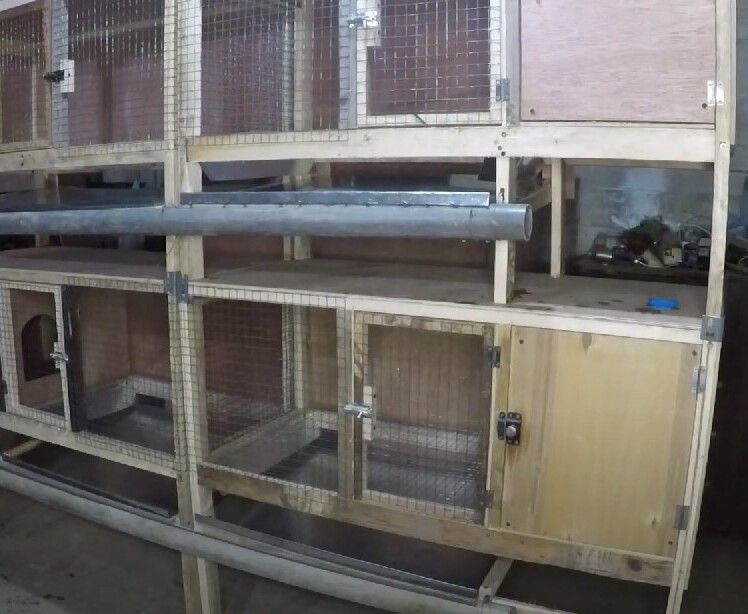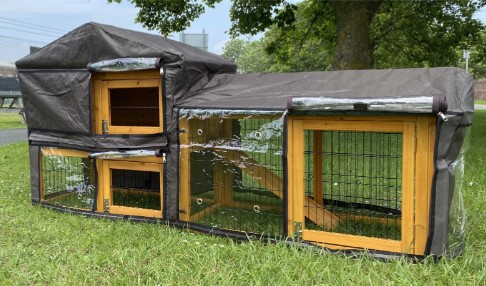Yes, rabbits need a hutch cover in the winter for protection from the cold weather. A hutch cover provides an extra barrier against drafts, wind, rain, and snow. It helps insulate the hutch and regulates temperature. A covered hutch will stay warmer in winter and cooler in summer. Be sure to use a waterproof, durable material like treated canvas or plastic. Leave one side uncovered for ventilation. A hutch cover is an easy way to help keep your rabbits comfortable year-round.
Winter can be hard for outdoor rabbits. Their hutches need extra care when it gets cold. Rabbits don’t like drafts, rain, snow, or ice. A good hutch cover keeps all these things out. It acts like a shield to protect the rabbits. Without a cover, they could get sick. A cover keeps them warm and dry inside.
In this article, we talk about the importance of rabbit hutch covers, and picking and using the right hutch cover for winter. Without further ado, let’s get started.
Do Rabbits Need a Hutch Cover in Winter?
Yes, rabbit hutches need some form of protective cover during the winter months. An uncovered outdoor hutch leaves domestic rabbits vulnerable to harsh weather and temperature extremes that can be very dangerous.
A good hutch cover provides insulation, blocks wind, and drafts, and creates a waterproof barrier against rain, snow, and ice. It helps regulate the interior temperature to prevent cold stress while still allowing for necessary ventilation.
Other winter care like extra bedding, increased food rations, and monitoring for illness are also vital. But a hutch cover is the first line of defense in safeguarding rabbit health and wellbeing through challenging winter conditions.
Taking the time to properly cover and weatherize rabbit housing ensures backyard bunnies can continue to thrive with their outdoor enclosures all season long. Don’t risk your rabbits’ health. keep them comfortable in the cold with a sturdy, sheltering hutch cover.

Is it cruel to keep rabbits outside?
There are differing opinions on whether it is cruel to keep rabbits outdoors. Here is a balanced perspective:
On one hand, some argue that keeping rabbits outdoors exposes them to temperature extremes, predators, and a potential lack of human interaction or supervision. Rabbits are domesticated animals that may not have the instincts or physical adaptations to thrive outdoors. Their well-being depends on the diligence of their owners to provide proper housing, weather protection, predator-proof enclosures, ample space for exercise, and daily attention. The lack of these provisions could be considered cruel.
On the other hand, many believe that rabbits can do well in outdoor housing if their needs are appropriately met. Some key considerations for humane outdoor keeping include:
- Providing a sturdy hutch that is off the ground, with rooms for sleeping/hiding and exercising.
- Use covers or insulation to protect from harsh weather and ensure a comfortable temperature range.
- Supplying enrichment activities for mental stimulation.
- Letting rabbits access secure outdoor play areas for added space to roam.
- Maintaining regular interaction and monitoring of health/behavior.
- Safeguarding the hutch and rabbits from predators.
Keeping rabbits outdoors has risks. But it is not always cruel. Outdoor housing can meet a rabbit’s needs. It can make them comfortable and safe. Whether inside or outside, responsible care is key. What matters most is the rabbit’s welfare. With the right provisions, rabbits can enjoy being outdoors. Many rabbits adapt well to outdoor living.
Why should you use Hutch cover in winter?
Here are some details on the main reasons to use a hutch cover in winter:
Insulation against cold temperatures
- Rabbits are susceptible to drafts and chills. Covers provide an extra barrier against wind and cold air.
- Covers trap body heat inside the hutch, keeping the interior warmer than outside temperatures.
- Insulated fabric covers designed for pet enclosures add even more protection from the cold.
Block wind and drafts
- Strong winds can blow rain, snow, and cold air into an uncovered hutch.
- Wind flaps the hutch walls, creating drafts. Covers seal and reinforce the walls.
- Straps or ties keep covers firmly in place even in windy conditions.
Keep hutches dry
- Rainfall and melting snow/ice can soak into the hutch interior without a cover.
- Wet conditions chill rabbits and raise health risks. Waterproof covers keep hutches dry inside.
- Some covers have sloped/rounded tops to prevent snow or rain from accumulating on top.
Protect from falling snow and ice
- Snow piles up on hutches, weighing down the roof and walls over time.
- Icicles or chunks of ice can break off from trees/structures overhead.
- Covers form a shield above the hutch to protect rabbits from heavy snow loads and falling icy debris.

Types of materials for hutch covers
Tarps
Tarps are a cheap choice for temporary covers. But they rip easily and must be checked a lot. They flap loose in the wind too. Ropes and bungees hold tarps tighter.
Wood panels
Wood panels make a sturdier cover. They last longer in bad weather. But wood is heavy and hard to move. Cut holes in the wood so the hutch can breathe.
Special insulated fabric
Special insulated fabric is made for pet homes outside. It has a tough polyester layer with insulation inside. This fabric keeps the cold out well. It’s more expensive but lasts a long time. Some have see-through plastic for light.
Canvas
Canvas is durable, weather-resistant cotton. It’s lighter than wood but still strong. The material needs to be treated to become waterproof. Tie it down tight with grommets and ropes.
Coroplast
Coroplast is a lightweight plastic that won’t rot. It stands up to the weather and is easy to clean. Cut the plastic to perfectly fit the hutch shape. But it can’t breathe, so cuts into air holes.
You could also Check:
Tips for selecting and using a hutch cover
Here are some tips for selecting and using a rabbit hutch cover:
- Measure your hutch carefully before buying a cover. Get the length, width, and height. Covers that fit well protect better.
- Look for thick, waterproof materials. Covers that keep drafts, rain, and snow out will insulate best.
- Make sure the covers have sturdy straps or ties. These keep the cover secured in windy or stormy conditions.
- Check that the cover allows a little airflow. A cover that is too tight can trap moisture inside.
- Use covers with reflective exterior layers. This bounces light and warmth back into the hutch.
- Layer covers over extra bedding like straw or blankets for more warmth. But leave room for rabbits to move around.
- Check under the cover often for leaks, tears, or loose spots. Fix any issues so protection doesn’t fail.
- Remove snow piles from the top of the cover so the weight doesn’t collapse the hutch roof.
- Make sure human activity near the hutch doesn’t startle rabbits under the covered enclosure.
Other winter preparations for Outdoor Bunny
Here are some other useful winter preparations for outdoor rabbit hutches:
Providing Extra Bedding
Having deep, thick bedding gives rabbits insulation against the cold ground. Use lots of straw, hay, or even shredded paper. Make sure rabbits can burrow into bedding for nesting warmth. Refresh bedding often if it gets damp or packed down.
Increasing Food Rations
The energy spent keeping warm means more calories needed. Give extra pellets and unlimited hay in winter. Provide water-rich vegetables too. Check that rabbits are maintaining a healthy weight.
Preventing Water Freezing
Dehydration is a risk when water bottles freeze. Use plastic bottles with double ball bearings. Insulate bottles with covers or place them inside larger bottles. Check water supplies multiple times daily.
Finding Sheltered Locations
Position hutches away from wind, rain, and drafts if possible. Place against house walls or in garages for added building insulation. Avoid low-hanging trees where snow and ice accumulate.
Monitoring Rabbits Closely
Do daily health checks under the cover. Watch for signs of respiratory illness. Weigh rabbits weekly to ensure they are eating sufficiently. Act quickly if concerns arise.
FAQ On rabbit hutch covers
Do rabbits get cold at night?
Rabbits can easily tolerate moderate to cold weather. Moreover, They can not survive in extremely hot weather (without a few breeds). They can tolerate up to -2 degrees Celcius (28.4°F). If they are kept in a well-insulated hutch they can tolerate near the freezing temperature. However, the idle temperature for pet rabbits is between 55 and 70 degrees Fahrenheit.
Do rabbit hutches need covering at night?
In the winter, you could cover the hutch at night if you keep it outside. Just don’t cover it heavily. Your bunny will be scared. Leave plenty of room and ventilation. In complete darkness, the rabbit will be frightened.
Can you put a blanket over a rabbit hutch?
A rabbit hutch should not be covered with a blanket. During the harsh winter, many of us cover the rabbit hutch with blankets, bedsheets, and other things. However, this is not ideal. You don’t even need a hutch cover if you have a weatherproof rabbit hutch with a sleeping cottage.
Do rabbit hutches need rain covers?
During rainy weather, you should cover the rabbit hutch. Having a rabbit hutch fitted with a rain cover is not necessary. Your rabbit hutch will stay dry and protected from cold air, snow, and rain if you have a weatherproof cover. You could cover your rabbit hutch with large polythene or something similar if you don’t have one.
Final Thoughts
Keeping your outdoor rabbits happy and healthy through tough winter weather takes work, but it’s doable! Good, snug hutch covers are gonna be clutch for insulation and keeping out cold nastiness. Check on the buns daily, re-up supplies often, and fix any cover issues ASAP. With a little extra effort to winter’s challenges, backyard bunnies can be just as comfy and content when it’s icy as their indoor cousins! Handle the cold months right and your rabbits will hop right through ’em.
Recent Posts
You may have already adopted a bunny or are planning to get one. Rabbits are a great source of pleasure for a family, especially children. They are peaceful and need moderate space for...
Perhaps, you have already adopted a bunny and now looking for an effective suggestion for a rabbit cage setup. Well, setting up a rabbit cage is not a difficult task indeed. If you have the proper...
